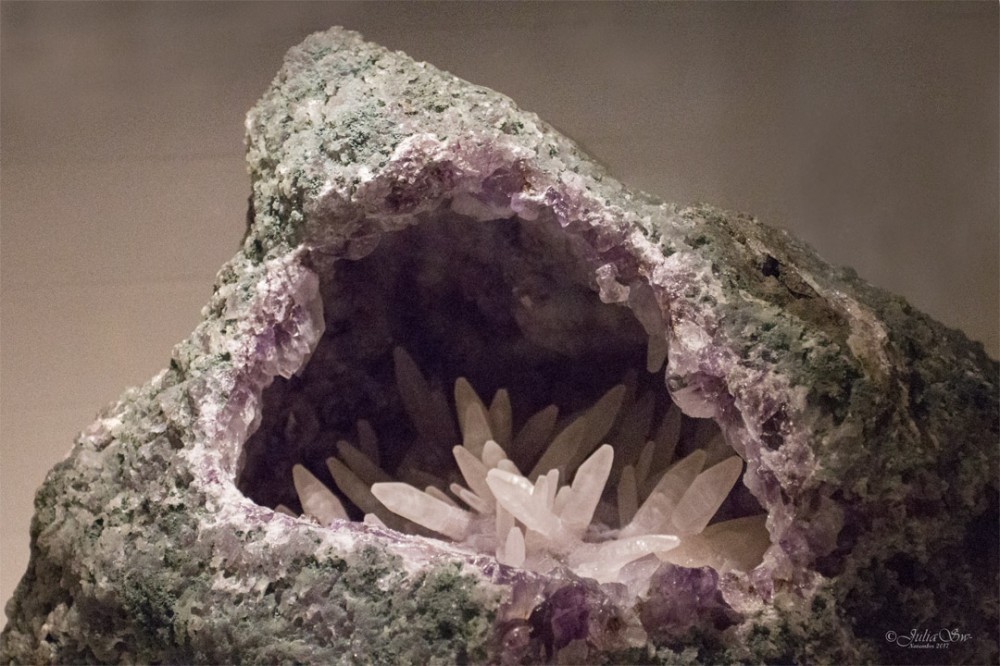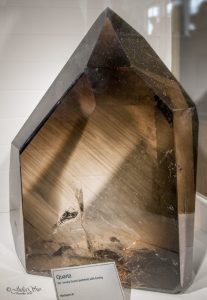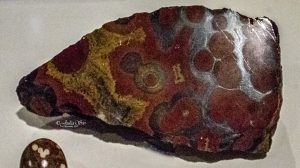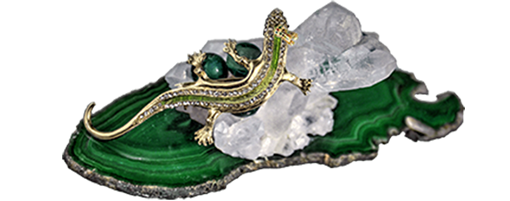Quartz & Chalcedony
I am going to introduce to you another colorful and very interesting group of gemstones. In this article, I will give an overview of the quartz family and a unique feature of the chalcedony group as a member of this large family. I’ll give the examples of the gemstones in each group of quartz, and will discuss them in greater details in the future articles. I hope that you’d be able to recognize some names of the gemstones discussed here, but I wonder if you knew that they were related to each other and belonged to the quartz family.

What is Quartz?
Quartz is the second most abundant mineral in Earth’s continental crust, behind feldspar. Chemically, it is a dioxide of silicon (SiO2). Of all the minerals in the world, it is the one that has served a man the longest, and with a wider range of uses. A million years ago, a primitive man used quartz in the form of flint for some of his first crude scrapers and grinders. Today, we make quartz crystals resonators for electronic oscillators, which are used in clocks and watches, radio systems and many electronic devices. Throughout all these years, in one or another of its varied manifestations, quartz has not only served the artisan and the engineer but has also intrigued the scientist and attracted the artist.
Quartz occurs in two different forms: as large distinct crystals or crystal grains – macrocrystalline, or as masses composed of billions exceedingly minute crystals, too small to see clearly even under strong magnification – microcrystalline or cryptocrystalline. The word “crystalline” comes from old French cristallin, and means “like crystal”, or “composed of crystals. “Macro-” and “micro-” prefixes come from Greek and mean “large” and “small” accordingly. “Crypto-” in translation from ancient Greek means hidden or invisible. Therefore, microcrystalline and cryptocrystalline can be used interchangeably
If quartz were less common, it might rank higher as a gem. It has all the other qualities to make it desirable: a hardness of 7 on the Mohs scale, no distinct cleavage, and beautiful colors in the transparent crystalline variety. The range of quartz is enormous, from a clear and transparent crystal to an opaque solid mass.

The examples of gemstones in the macrocrystalline form of quartz family are:
- Aventurine
- Ametrine
- Amethyst
- Smoky Quartz
- Citrine
- Tiger’s, Hawk’s, and Cat’s Eye
- Prasiolite or vermarine
What is Chalcedony?
A chalcedony is a mineral group, which belongs to the quartz family and is categorized by the quartz crystal structure and size. Chalcedony is the microcrystalline or cryptocrystalline form of quartz.
There is further differentiation in the classification of the cryptocrystalline form of quartz: “fibrous” and “grainy” varieties. The names of the subgroups are a bit misleading as both consist of microscopically small intergrown crystal grains. The distinction between the two is based on the visual appearance of thin sections in a polarizing microscope.
Even if you are not familiar with the name “chalcedony”, you’ve probably heard of at least some of its colorful members:
Fibrous varieties:

- Agate
- Onyx
- Sardonyx
- Sard
- Carnelian

Grainy varieties:
- Jasper
- Bloodstone or heliotrope
- Plasma
- Chert
- Flint
Industrial Use of Quartz Crystals and Quartz Sand:
Quartz crystals are widely used in the modern electronic technologies because of their piezoelectric property, which means that the crystals generate an electric potential in response to the mechanical stress. The effect can also be reversed: the applied current causes a crystal to resonate and produce a vibration. The quartz crystal oscillators are used in watches and clocks, computers, GPS, cellular phones, video cameras, radio systems, etc.
 Do you remember another gem (a hint for you: it’s an organic jewel), which was also associated with the electricity? If so, please write its name in the comments below. Here is another hint: its name in ancient Greece was “electron”, and the gem becomes statically charged when rubbed with a cloth. This link will take you to the answer, but first, try to think of a name on your own.
Do you remember another gem (a hint for you: it’s an organic jewel), which was also associated with the electricity? If so, please write its name in the comments below. Here is another hint: its name in ancient Greece was “electron”, and the gem becomes statically charged when rubbed with a cloth. This link will take you to the answer, but first, try to think of a name on your own.
Quartz sands also have very wide industrial application. High purity silica sand is used in the glassmaking industry. The high hardness of quartz makes it an excellent abrasive material. Quartz sands and finely ground silica sand are used for scouring cleansers, grinding media, and sand blasting. Quartz sands are used in petroleum industry, for traction in the railroad and mining industries, as a filler in the manufacture of rubber, putty, and paint.
To satisfy the industrial demand, synthetic quartz crystals, grown by a hydrothermal process, are produced in enormous quantities.
Metaphysical Properties
It is scientifically proven that quartz can transform energy from one form to another. From metaphysical perspectives, quartz crystals have six properties. They are able to transmit, transform, focus, structure, store, and amplify energy. Quartz crystals work like tuning forks for our bodies. They return energy frequencies to their healthiest natural state. The crystals cleanse, balance, heal and strengthen the chakras resulting in physical and mental well-being.
Please comment, ask questions, request new topics or simply say “hello!” in the Comments below. I always look forward to hearing from you.

Hi Julia,
fascinating article. Thank you.
Hi CD,
I hope you found what you were looking for. I’ve taken this photo of smoky quartz in the mineral collection of the Harvard Museum of Natural History, It’s a huge crystal and it’s gorgeous. Could see the specimen’s translucency in the picture? If you click on the photo, it’ll enlarge.
Thank you very much for the comment.
~ Julia